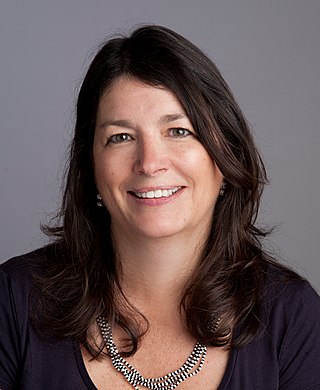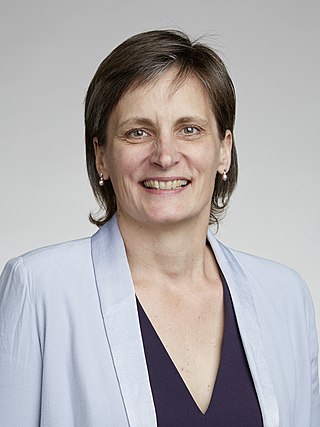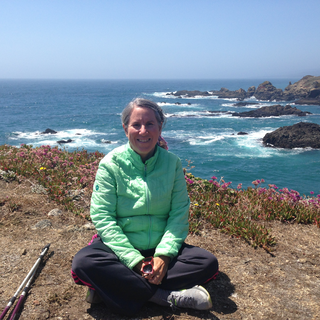
Melvin Ellis Calvin was an American biochemist known for discovering the Calvin cycle along with Andrew Benson and James Bassham, for which he was awarded the 1961 Nobel Prize in Chemistry. He spent most of his five-decade career at the University of California, Berkeley.
The Suess effect is a change in the ratio of the atmospheric concentrations of heavy isotopes of carbon (13C and 14C) by the admixture of large amounts of fossil-fuel derived CO2, which contains no 14CO2 and is depleted in 13CO2 relative to CO2 in the atmosphere and carbon in the upper ocean and the terrestrial biosphere. It was discovered by and is named for the Austrian chemist Hans Suess, who noted the influence of this effect on the accuracy of radiocarbon dating. More recently, the Suess effect has been used in studies of climate change. The term originally referred only to dilution of atmospheric 14CO2 relative to 12CO2. The concept was later extended to dilution of 13CO2 and to other reservoirs of carbon such as the oceans and soils, again relative to 12C.

In geochemistry, paleoclimatology, and paleoceanography δ13C is an isotopic signature, a measure of the ratio of the two stable isotopes of carbon—13C and 12C—reported in parts per thousand. The measure is also widely used in archaeology for the reconstruction of past diets, particularly to see if marine foods or certain types of plants were consumed.
Joy K. Ward is a leading evolutionary biologist studying the impact of the environment on plants and ecosystems. She began a new role as the dean of the College of Arts & Sciences at Case Western Reserve University on July 1, 2020 - leaving behind her professorship at the University of Kansas. Her research on plant life has gained her notoriety in many scientific research fields. Aside from her work in the lab, she is also a strong advocate for advancing underrepresented communities' scientific learning and careers. As part of her deanship at the University of Kansas, Ward was an important factor in increasing the number of underrepresented individuals who held faculty positions in STEM subjects. Notably, as a result of her research efforts, she was awarded the Presidential Early Career Award for Scientists and Engineers by U.S. President Barack Obama.

Maureen E. "Mo" Raymo is an American paleoclimatologist and marine geologist. She is the Co-Founding Dean Emerita of the Columbia Climate School and the G. Unger Vetlesen Professor of Earth & Environmental Sciences at Columbia University. From 2011 to 2022 she was also the Director of the LDEO Core Repository and until 2024 was the Founding Director of the LDEO Hudson River Field Station. From 2020 to 2023 she was first Interim Director then Director of Lamont-Doherty Earth Observatory, the first climate scientist and first female scientist to head the institution.

Jasper A. Vrugt is a Dutch scientist/engineer/applied mathematician known for his work in the earth sciences: surface hydrology, soil physics, hydrogeophysics, hydrometeorology, and geophysics. Vrugt is an assistant professor at the University of California, Irvine and holds a joint appointment in the Department of Civil and Environmental Engineering and the Department of Earth System Science. He also holds a part-time appointment as associate professor at the University of Amsterdam, Faculty of Science (CGE).
Steven J. Davis is an earth system scientist at the University of California, Irvine's Department of Earth System Science and holds a joint appointment in the Department of Civil and Environmental Engineering He is a highly cited researcher.

Marie Corinne Lyne Le Quéré is a Canadian scientist. She is Royal Society Research Professor of Climate Change Science at the University of East Anglia and former Director of Tyndall Centre for Climate Change Research. She is the chair of the French High Council on Climate and member of the UK Climate Change Committee. Her research focuses on the interactions between the carbon cycle and climate change.
Isabel Patricia Montañez is a paleoclimatologist specializing in geochemical records of ancient climate change. She is a distinguished professor and a Chancellor's Leadership Professor in the department of earth and planetary sciences at University of California, Davis. As of 2021, Montañez is the director of the UC Davis Institute of the Environment.
Kliti Grice, is a chemist and geochemist known for her work in identifying geological and environmental causes for mass extinction events. Her research integrates geological information with data on molecular fossils and their stable carbon, hydrogen and sulfur isotopic compositions to reconstruct details of microbial, fungal and floral inhabitants of modern and ancient aquatic environments and biodiversity hot spots. This information expands our understanding of both the Earth's history and its current physical state, with implications ranging from energy and mineral resource exploration strategies to environmental sustainability encompassing climate dynamics and expected rates, durations and scale of our future planet's health. As one of the youngest women professors in Earth Sciences, she is the founding director of the Western Australian Organic and Isotope Geochemistry Centre (WA-OIGC) and is a Professor of Organic and Isotope Geochemistry at Curtin University in Perth, Western Australia.

Lab Girl is a 2016 memoir by the American geochemist, geobiologist and professor Hope Jahren, published by Alfred A. Knopf. It is the recipient of the National Book Critics Circle Award for Autobiography, a New York Times notable book, winner of the American Association for the Advancement of Science prize for Excellence in Science Books, a finalist for the PEN/E.O. Wilson Literary Science Writing Award, and was named one of the Best Books of the Year by The Washington Post, Time, NPR, Slate, Entertainment Weekly, Newsday, Minneapolis Star Tribune and Kirkus Reviews.

Marilyn L. Fogel was an American geo-ecologist and Professor of Geo-ecology at UC Riverside in Riverside, California. She is known for her research using stable isotope mass spectrometry to study a variety of subjects including ancient climates, biogeochemical cycles, animal behavior, ecology, and astrobiology. Fogel served in many leadership roles, including Program Director at the National Science Foundation in geobiology and low-temperature geochemistry.
Ronald Amundson is an American environmental scientist who is currently Professor at University of California, Berkeley.
Lisa Welp is a biogeochemist who utilizes stable isotopes to understand how water and carbon dioxide are exchanged between the land and atmosphere. She is a professor at Purdue University in the department of Earth, Atmosphere, and Planetary Sciences.
Diane E. Pataki is a Foundation Professor and Director of the School of Sustainability at Arizona State University.
Pamela H. Templer is an ecosystem ecologist and professor at Boston University who focuses on plant-microbial interaction and their effect on carbon exchange and nutrient cycling. She is also interested in examining how urban ecosystems function, how human actions influence nutrient cycling, atmosphere-biosphere interactions, and other ecosystem processes.
Rosalind Emily Majors Rickaby is a professor of biogeochemistry at the Department of Earth Sciences, University of Oxford and a Professorial Fellow at University College, Oxford. She is an Emeritus Fellow of Wolfson College, Oxford.
M. Francesca Cotrufo is a soil ecologist who focuses her work on litter decomposition and the dynamics of soil organic matter. She is currently a Professor and Associate Head in the Department of Soil and Crop Sciences, as well the Senior Scientist at the Natural Resource Ecology Lab, at Colorado State University.
Celina A. Suarez is an American geologist. She is known for her research on using trace element and stable isotope geochemistry of fossil vertebrates and invertebrates to understand paleoecology, paleoclimatology, and taphonomy of ancient terrestrial ecosystems. She is an associate profession in the Department of Geosciences at the University of Arkansas. The dinosaur Geminiraptor suarezarum is named after Suarez and her twin sister, Marnia Suarez, co-discovers of the site on which it was found.

Dan Yakir is an Israeli Ecophysiologist and a Professor in the Department of Earth and Planetary Sciences at the Weizmann Institute of Science. Yakir is a 2019 recipient of the Israel Prize for Research in Geology, Earth Sciences and Atmospheric Sciences.








